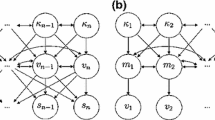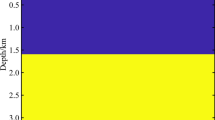Abstract
The generalized mixture rule (GMR) is usually applied in determining mechanical properties such as the rheological property and Young’s modulus of multi-phase rocks. However, it is rarely used to determine electrical conductivity of multi-phase rocks presently. In this paper, we calculate the effective conductivity using the 3D finite element method for a large number of two-phase medium stochastic models. The GMR is then employed as an effective conductivity model to fit the data. It shows a very close relationship between the parameter J of GMR and the ratio of conductivities of the two phases. We obtain the equations of the parameter J with the ratio of conductivity of two phases for the first time. On this basis, we can quickly predict (or calculate) the effective conductivity of any two-phase medium stochastic model. The result is much more accurate than two other available effective conductivity models for the stochastic medium, which are the random model and effective medium theory model, laying a solid base for detailed evaluation of oil reservoirs.
Similar content being viewed by others
References
Archie, G. E., 1942, The electrical resistivity log as an aid in determining some reservoir characteristics: Trans. Am. Inst. Min. Metall. Pet. Eng. 146, 54–62.
Bigalke, J., 1999, Investigation of the conductivity of random networks: Physica A, 272, 281–293.
—, 2000, A study concerning the conductivity of porous rocks: Phys. Chem. Earth A, 25, 189–194.
—, 2003, Analysis of conductivity of random media using dc, MT, and TEM: Geophysics, 68(2), 506–515.
Fiori, A., Jankovic, I., and Dagan, G., 2005, Effective conductivity of heterogeneous multiphase media with circular inclusions: Physical Review Letters, 94, 224502.
Garboczi, E. J., 1998, Finite element and finite difference programs for computing the linear electric and elastic properties of digital images of random materials: NISTIR 6269, United States Department of Commerce Technology Administration, National Institute of Standards and Technology.
Gueguen, Y. and Palciauskas, V., 1994, Introduction to the physics of rocks: Princeton University Press, Princeton, NJ.
Glover, P. W. J., Hole, M. J., and Pous, J., 2000a, A modified Archie’s law for two conducting phases: Earth Planet Sci. Lett., 180(3–4), 369–383.
Glover, P. W. J., Pous, J., Queralt, P., Munoz, J. A., Liesa, M., and Hole, M. J., 2000b, Integrated two-dimensional lithospheric conductivity modeling in the Pyrenees using field-scale and laboratory measurements: Earth Planet Sci. Lett., 178, 59–72.
Hashin, Z., and Shtrikman, S., 1962, A variational approach to the theory of effective magnetic permeability of multiphase materials: J. Appl. Phys., 33, 3125–3131.
Hakobyan, Y., Papoulia, K. D., and Grigoriu, M. D., 2007, Physical and geometrical percolations of effective conductivity on a lattice: Phys. Rev. B, 76, 144205.
Holland, K. G., and Ahrens, T. J., 1997, Melting of (Mg, Fe)2SiO4 at the core-mantle boundary of the earth: Science, 275(5306), 1623–1625.
Ji, S. C., 2004a, A generalized mixture rule for estimating the viscosity of solid-liquid suspensions and mechanical properties of polyphase rocks and composite materials: J. Geophys. Res, 109, B10207.
—, 2004b, Generalized means as an approach for predicting Youngs moduli of multiphase materials: Mater. Sci. Eng. A, 366, 195–201.
Ji, S. C., Wang, Q., Xia, B., and Xu, Z. Q., 2006, Generalized mixture rule and its applications to rheology of the Earth materials: Acta Petrologica Sinica (in Chinese), 22(7), 2067–2080.
Landauer, R., 1952, The electrical resistance of binary metallic mixtures: J. Appl. Phys., 23, 779–784.
Lebovka, N. I., Tarafdar, S., and Vygornitskii, N. V., 2006, Computer simulation of electrical conductivity of colloidal dispersions during aggregation: Phys. Rev. E, 73, 031402.
Li, J. H., 2005, Study on the whole conductivity of mixture: Chinese J. Geophys. (in Chinese), 48(6), 1406–1411.
Liu, X. F., Sun, J. M., and Wang, H. T, 2009, Numerical simulation of rock electrical properties based on digital cores: Applied Geophysics, 6(1), 1–7.
Ma, X. B., Kong, X. R., Liu, H. B., and Yan, Y. L., 2005, The electrical structure of northeastern Qinghai Tibet Plateau: Chinese J. Geophys.(in Chinese), 48(3), 689–697.
Maxwell, J. C., 1873, A treatise on electricity and magnetism: Clarendon Press, Oxford.
McLachlan, D. S., Blaszkiewicz, M., and Newnham, R. E., 1990, Electrical resistivity of composites: Journal of the American Ceramic Society, 73(8), 2187–2203.
McLachlan, D. S., 1989, Measurement and analysis of a model dual conductivity medium using a generalized effective medium theory: Physica A, 157(1), 188–191.
Schilling, F. R., Partzsch, G. M., Brasse, H., and Schwartz, G., 1997, Partial melting below the magmatic arc in the central Andes deduced from geoelectric field experiments and laboratory data: Phys. Earth Planet. Int., 103, 17–31.
Shankland, T. J., and Waff, H. S., 1977, Partial melting and electrical conductivity anomalies in the upper mantle: J. Geophys. Res., 82, 5409–5417.
Tao, G., Yue, W. Z., and Xie, R. H., 2005, A new method for theoretical modeling and numerical experiments on petrophysical studies: Progress in Geophysics (in Chinese), 20(1), 4–11.
Waff, H. S., 1974, Theoretical consideration of electrical conductivity in a partially molten mantle and implications for geothermometry: J. Geophys. Res., 79, 4003–4010.
Warren, J. E., and Price, A. S., 1961, Flow in heterogeneous porous media: Trans. AIME (SPEJ), 222, 153–183.
Wu, X. P., 2003, A 3-D finite-element algorithm for DC resistivity modeling using shifted incomplete Cholesky conjugate gradient method: Geophys. J. Int., 154(3), 947–956.
Wu, X. P., and Wang, T. T., 2003, A 3-D finite-element resistivity forward modeling using conjugate gradient algorithm: Chinese J. Geophys. (in Chinese), 46(3), 428–432.
Xu, Y. S., Shankland, T. J., and Poe B. T., 2000, Laboratorybased electrical conductivity in the Earth’s mantle: J. Geophys. Res., 105(B12), 27865–27876.
Yue, W. Z., Li, Z., Zhu, K. Q., and Tao, G., 2005, The simulation of conductivity of binary mixtures with lattices Boltzmann method: Chinese J. Geophys. (in Chinese), 48(2), 434–438.
Author information
Authors and Affiliations
Corresponding author
Additional information
The paper is sponsored by National Natural Science Foundation of China (Grant No. 40874034) and the Knowledge Innovation Program of the Chinese Academy of Sciences (Grant No. KZCX2-YW-QN508).
Yu Yong is a graduate student at the University of Science and Technology of China (USTC). He graduated with a Bachelor’s degree from USTC in 2007 and received his Master’s degree in 2010 at USTC. He focuses on the 3-D geo-electromagnetic modeling and rock physics.
Rights and permissions
About this article
Cite this article
Yu, Y., Wu, X. Study of the generalized mixture rule for determining effective conductivity of two-phase stochastic models. Appl. Geophys. 7, 210–216 (2010). https://doi.org/10.1007/s11770-010-0248-3
Received:
Revised:
Published:
Issue Date:
DOI: https://doi.org/10.1007/s11770-010-0248-3




